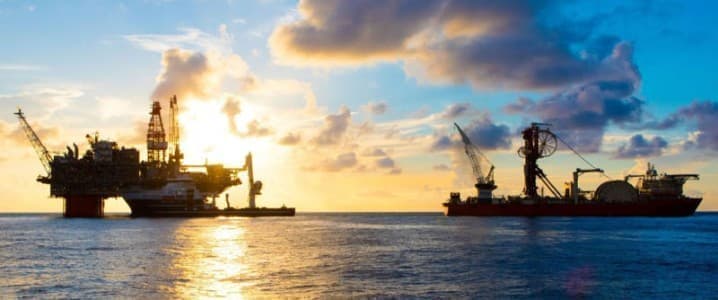Business
U.S. Oil Production Shifts Focus to Gulf as Shale Growth Slows

U.S. oil production is experiencing a significant transition, moving from shale fields to offshore drilling in the Gulf of Mexico. This shift is driven by technological advancements, the maturation of shale reservoirs, and supportive federal policies aimed at bolstering oil output. According to the U.S. Energy Information Administration, Gulf oil production is projected to increase from 1.8 million barrels daily to 2.4 million barrels daily by 2027. The Bureau of Ocean Energy Management corroborated this forecast, highlighting a favorable environment for offshore investments.
One major player, BP, recently announced plans to invest $5 billion in the Tiber-Guadalupe offshore project, anticipating the addition of 80,000 barrels daily to its overall U.S. output. The company is eyeing a total production target of over 1 million barrels daily. In a related development, BP, in partnership with Chevron, made a significant discovery in the Far South prospect, reinforcing the Gulf’s potential for growth. An executive from BP stated, “This Far South discovery demonstrates that the Gulf of America remains an area of incredible growth and opportunity for BP.”
The trend is not limited to BP. Talos Energy reported a substantial discovery in the Gulf, which analysts from Wood Mackenzie described as the most significant since Shell’s Whale find in 2017. The Daenerys discovery is expected to yield up to 65,000 barrels daily at peak production. Paul Goodfellow, CEO of Talos Energy, emphasized the need for offshore production to meet global energy demands, stating, “Questions are starting to arise about the continued long-term economic viability of onshore basins.”
For years, shale drilling has been favored due to its quick production capabilities. However, the rapid depletion of shale wells has led to increased costs and a cautious approach among producers. Some industry executives noted that while current oil prices are manageable, rising costs and political uncertainties make long-term investments risky. The Dallas Fed Energy Survey highlighted this sentiment, with one executive stating, “We can make money at today’s oil prices. But with costs climbing and politics in play, we’d rather pay dividends than take big risks.”
In contrast, offshore drilling typically involves higher initial costs, but advancements in technology have made it more economically viable. New equipment allows for drilling in deeper waters, unlocking previously inaccessible reserves. Talos Energy’s Goodfellow indicated that their offshore projects remain profitable even if international oil prices fall to $35 per barrel, with breakeven points potentially dropping to $20 per barrel. Comparatively, onshore oil breakeven averages around $48 per barrel.
The Energy Information Administration forecasts Gulf oil production will reach 1.89 million barrels daily this year, with continued growth expected to 1.96 million barrels daily by 2026. In contrast, onshore production is set to grow by only 190,000 barrels daily, marking the slowest growth since 2010, excluding the pandemic years. Analysts from Energy Aspects predict that offshore growth could fully compensate for the decline in onshore production, provided that favorable federal policies remain in place.
The current administration’s emphasis on local energy production has facilitated offshore growth by relaxing regulations and enhancing productivity. Should political power shift, particularly with a Democratic administration, the outlook for offshore oil could change dramatically. The evolving landscape of U.S. oil production underscores a pivotal moment in the industry, as companies adapt to market demands and technological innovations. As the Gulf of Mexico emerges as a critical player in the energy sector, the implications for both domestic and global markets may be substantial.
-

 Health4 days ago
Health4 days agoRare Brain Condition Discovered More Common in New Mexico
-

 Politics5 days ago
Politics5 days agoPrince Andrew Steps Back from Royal Duties Following Epstein Memoir
-

 Health5 days ago
Health5 days agoRemembering Mary Ingleby: A Life of Love, Teaching, and Music
-

 Sports5 days ago
Sports5 days agoMLS Decision Day 2025: Playoff Spots on the Line as Teams Clash
-

 Science5 days ago
Science5 days agoIdaho State University Launches Haunted Science Laboratory on Oct. 25
-

 World5 days ago
World5 days agoYoung Driver Dies in Collision with Box Truck in El Cajon
-

 Lifestyle5 days ago
Lifestyle5 days agoKent Hamilton Named Southeastern Farmer of the Year at Expo
-

 Business5 days ago
Business5 days agoFirst National Bank of Groton’s Quiet Period Ends October 21
-

 Entertainment5 days ago
Entertainment5 days agoTrump Commutes George Santos’ Sentence, Sparks Controversy
-

 Politics5 days ago
Politics5 days agoNavy Veteran Max Quattromani Launches Campaign for Assessor Seat
-

 Sports5 days ago
Sports5 days agoSaquon Barkley Reacts to James Franklin’s Dismissal from Penn State
-

 World5 days ago
World5 days agoHamas to Return Additional Hostage Remains on Friday









